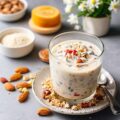As more people embrace plant-based diets or seek alternatives to dairy due to allergies or dietary preferences, homemade alternative milk has become increasingly popular. Making your own plant-based milk at home can be cost-effective, environmentally friendly, and tailored to your taste preferences. This guide will walk you through the process of making various types of alternative milk right in your kitchen.
Benefits of Homemade Alternative Milk
There are numerous benefits to making your own alternative milk at home:
- Cost-effective: Save money by making large batches of milk from inexpensive ingredients.
- No additives: Control exactly what goes into your milk, avoiding preservatives and unnecessary additives found in store-bought versions.
- Customizable: Adjust the sweetness, flavor, and thickness to suit your preferences.
- Eco-friendly: Reduce packaging waste by reusing containers and buying ingredients in bulk.
Common Ingredients for Homemade Alternative Milk
The main ingredients for homemade alternative milk are nuts, seeds, grains, and legumes. Here are some popular options:
- Almonds: Almond milk is creamy with a mild flavor and is a favorite for many.
- Cashews: Cashew milk has a rich, creamy texture and is great for coffee and cooking.
- Oats: Oat milk is smooth and has a slightly sweet taste, perfect for smoothies and cereals.
- Soybeans: Soy milk is high in protein and has a neutral flavor, making it versatile for many uses.
- Coconuts: Coconut milk is rich and flavorful, ideal for tropical dishes and baking.
- Rice: Rice milk is light and sweet, suitable for those with nut allergies.
Basic Steps for Making Homemade Alternative Milk
While the specific steps can vary slightly based on the ingredient, the basic process for making homemade alternative milk is generally the same:
- Soak: Soak your main ingredient (nuts, seeds, grains, or legumes) in water for several hours or overnight to soften them.
- Blend: Drain and rinse the soaked ingredients, then blend them with fresh water until smooth. The ratio is usually 1 cup of soaked ingredients to 4 cups of water.
- Strain: Pour the blended mixture through a nut milk bag, cheesecloth, or fine-mesh strainer to separate the liquid from the pulp.
- Store: Transfer the milk to a sealed container and refrigerate. Homemade alternative milk typically lasts 3-5 days in the fridge.
- Optional enhancements: Add sweeteners like dates or honey, flavorings like vanilla or cocoa, or a pinch of salt to enhance the taste.
Popular Homemade Alternative Milk Recipes
Homemade Almond Milk
Ingredients:
- 1 cup raw almonds
- 4 cups water
- Optional: 2-3 dates for sweetness, 1 tsp vanilla extract
Instructions:
- Soak the almonds in water overnight.
- Drain and rinse the almonds.
- Blend the almonds with 4 cups of water until smooth.
- Strain the mixture using a nut milk bag or cheesecloth.
- Optional: Blend the strained milk with dates and vanilla for added sweetness and flavor.
- Transfer to a container and refrigerate for up to 5 days.
Homemade Oat Milk
Ingredients:
- 1 cup rolled oats
- 4 cups water
- Optional: 1-2 tbsp maple syrup, 1 tsp vanilla extract
Instructions:
- Soak the oats in water for 30 minutes.
- Drain and rinse the oats.
- Blend the oats with 4 cups of water until smooth.
- Strain the mixture using a nut milk bag or cheesecloth.
- Optional: Blend the strained milk with maple syrup and vanilla for added sweetness and flavor.
- Transfer to a container and refrigerate for up to 5 days.
Tips for Perfect Homemade Alternative Milk
To ensure your homemade alternative milk turns out perfectly every time, follow these tips:
- Use fresh ingredients: Ensure your nuts, seeds, or grains are fresh and of high quality.
- Blend thoroughly: Blend the ingredients long enough to break them down completely for a smooth consistency.
- Strain well: Strain the mixture thoroughly to remove any pulp, ensuring a smooth milk.
- Experiment with flavors: Don’t be afraid to add different flavors and sweeteners to find your perfect blend.
- Store properly: Keep your milk in a sealed container in the fridge and use it within 3-5 days.
FAQ
How long does homemade alternative milk last?
Homemade alternative milk typically lasts between 3-5 days when stored in a sealed container in the refrigerator. Always check for any signs of spoilage before consuming.
Can I use homemade alternative milk in cooking and baking?
Yes, homemade alternative milk can be used in cooking and baking just like store-bought versions. It’s perfect for recipes that call for milk, such as smoothies, soups, sauces, and baked goods.
What can I do with the leftover pulp?
The leftover pulp can be used in various recipes to minimize waste. Try adding it to smoothies, baking it into cookies or bread, or using it as a base for homemade granola.
Do I need a high-powered blender to make homemade alternative milk?
While a high-powered blender can make the process easier and result in a smoother milk, it is not strictly necessary. A regular blender can also work, though you may need to blend for a longer time and strain more thoroughly.
Can I flavor my homemade alternative milk?
Yes, you can flavor your homemade alternative milk with natural sweeteners like dates, honey, or maple syrup, and add extracts like vanilla, almond, or cocoa for additional flavor.









